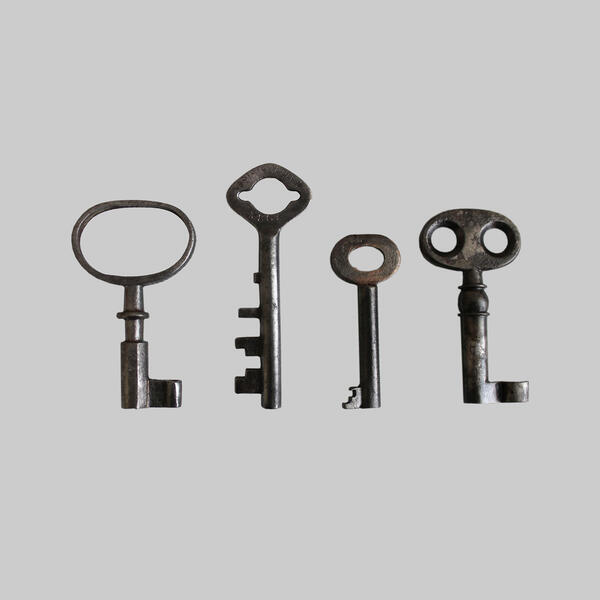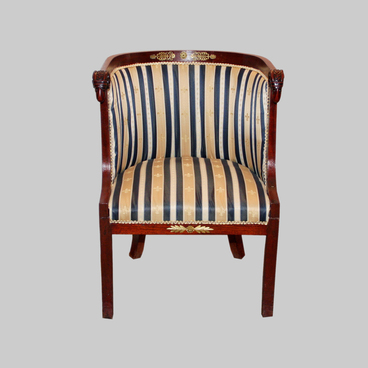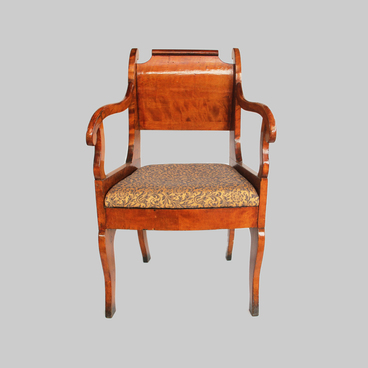The keys, which are presented in the Decembrists in Yalutorovsk exhibit, were discovered in 2010. Albina Bolotova, an employee of the Yalutorovsk Museum Complex, found them during the demolition of the house of the first director of the museum, Ivan Ozolin. His house was located on the territory of the former estate of Decembrist Matvey Muravyov-Apostol. Matvey Muravyov-Apostol owned a large plot of land. On the territory of the estate there were many buildings: a bathhouse, barns, a stable, a coach shed. There was an outbuilding next to the house, which housed the kitchen and living quarters for servants. It is assumed that the keys opened the locks in buildings located on the territory of the Matvey Muravyov-Apostol estate.
Keys of various shapes and shizes were found. Seven of them are solid-forged, that is, they consist of one part, and one is composite, prefabricated. All keys have cylindrical shafts. One of the keys is stamped with the words System DULV and the number 26. Thanks to the inscription, it was possible to establish that the key opens an old German-made padlock. Usually the number on the lock and key indicated its size, for example, the lock of this system # 15 was the size of a modern two-ruble coin, and # 25 was only 3.5 centimeters. The head, for which the key is usually held when opening, is made in the form of a diamond with a unique cut. The beard or so they call the part of the key that is inserted into the mechanism consists of four teeth of different lengths, widths and shapes.
The other key is decorated in the upper part with convex bands, and the beard consisted of two straight teeth 1 cm long, and the head was an oval.
Another key is decorated at the top with two convex wide belts. There was one short curly denticle on the beard with a cut in the middle. The composite key has a ring in the upper part; it was usually made large to make it easier to assemble the key. The key consisted of their head and stem. Some keys are handcrafted by master blacksmiths. The central cylinders are rolled and brazed from a flat sheet of iron. The keys were restored by metal restorers of the ‘State Autonomous Institution of Culture Museum Complex named after I.Ya. Slovtsov’.
Keys of various shapes and shizes were found. Seven of them are solid-forged, that is, they consist of one part, and one is composite, prefabricated. All keys have cylindrical shafts. One of the keys is stamped with the words System DULV and the number 26. Thanks to the inscription, it was possible to establish that the key opens an old German-made padlock. Usually the number on the lock and key indicated its size, for example, the lock of this system # 15 was the size of a modern two-ruble coin, and # 25 was only 3.5 centimeters. The head, for which the key is usually held when opening, is made in the form of a diamond with a unique cut. The beard or so they call the part of the key that is inserted into the mechanism consists of four teeth of different lengths, widths and shapes.
The other key is decorated in the upper part with convex bands, and the beard consisted of two straight teeth 1 cm long, and the head was an oval.
Another key is decorated at the top with two convex wide belts. There was one short curly denticle on the beard with a cut in the middle. The composite key has a ring in the upper part; it was usually made large to make it easier to assemble the key. The key consisted of their head and stem. Some keys are handcrafted by master blacksmiths. The central cylinders are rolled and brazed from a flat sheet of iron. The keys were restored by metal restorers of the ‘State Autonomous Institution of Culture Museum Complex named after I.Ya. Slovtsov’.



